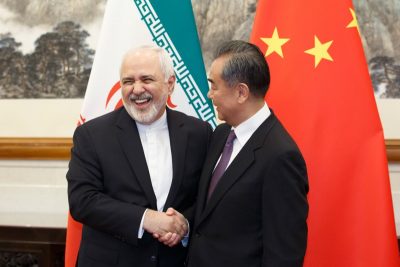Trump Administration’s Pressure Prompted Tehran and Damascus to Cultivate Ties with China

The Trump administration’s “maximum pressure” campaign against Iran and Syria involving economic sanctions has prompted Tehran and Damascus to cultivate ties with US-sanctioned and alienated China.
Tehran and Beijing have accelerated talks on a 25-year partnership begun in 2016, following the signing of the 2015 deal providing for a 90 per cent reduction of Iran’s nuclear programme in exchange for international sanctions relief.
Negotiations on the China-Iran partnership involving economic, political and security cooperation were launched when Chinese President Xi Jinping made a visit to Tehran where he met Iran’s supreme leader Ayatollah Ali Khamenei. A road map has now, reportedly, been approved by Iranian President Hassan Rouhani and talks will continue to finalise the deal. While the agreement’s provisions have not been revealed, China is expected to invest in transport, where it already has been involved in major projects, as well as healthcare, energy, tourism and communications. Last year, China, Iran and Russia conducted naval drills in the Indian Ocean with the aim of training for dealing with ship fires and pirates. Their political aim was to signal that the world’s oceans are not a US lake.
The partnership negotiations began in the halcyon days when Iran appeared to be emerging from the US-driven sanctions regime. At that time competing European and Asian businessmen flocked to Tehran to explore investment opportunities, particularly in the energy sector. Following the Trump administration’s 2018 withdrawal from the nuclear deal and the reimposition and tightening of sanctions on Tehran, the Iran-China partnership became an act of resistance and defiance.
By stepping up negotiations Iran and China made it clear that they see their partnership as a means to exert pressure on Europe, in particular, to break with the Trump administration’s policies of punishing both Tehran and Beijing for refusing to capitulate to Washington. Iran counts on both China and Russia to block the Trump administration’s attempt to force the Security Council to impose a fresh round of UN sanctions on Iran once the ban on Iranian purchases and sales of weaponry expires in October. The US has, so far, received no backing for its effort which is seen as illegitimate because the US pulled out of the nuclear deal which provides for the “snap back” of sanctions if Iran is referred to the Council for breaching the deal.
Iran expert Shireen T. Hunter argues in an article on the Middle East Eye website that if and when finalised and implemented, the deal would render Iran dependent on China in a number of fields as well as provide China with a presence in the Gulf, altering the balance of power in the region.
She writes,
“A major reason for Iran’s shift towards China and other Asian countries, known locally as the ‘pivot to the East’, has been the failure of Iran’s repeated efforts, beginning with the administration of Ayatollah Hashemi Rafsanjani [1989-97], to expand economic relations with the West as a prelude to better political ties.”
The most propitious time for reconciliation and the reintegration of Iran into the world community came during the liberalising and reformist presidency of Mohammed Khatami (1997-2005), who launched a campaign for “Dialogue Among Civilisations” and persuaded the UN to adopt 2001 as the year of dialogue.
Still smarting over the overthrow of its ally Shah Reza Pahlavi and the holding by radical Iranian students of Tehran’s US embassy personnel for 444 days, Washington rejected this opportunity, leaving Iran largely ostracised and isolated until the nuclear deal was implemented in January 2016. While there was an almost instant flowering of relations between world capitals and Tehran at that time, this came to an end with Trump’s rejection of the nuclear deal. This also put an end to European overtures to Iran.
Rebuffed and shamed by the US and its European acolytes, Iran is clearly determined to opt for the chief eastern alternative which, over the past decade, has emerged as a major political as well as economic power.
This is true also of Tehran’s ally, Damascus which, like Iran, suffers from a hardening sanctions regime which not only punishes Syria but also neighbouring Jordan and Lebanon. In the latter the economy has been in free fall for the past year.
Beijing put on a large display at last August’s Damascus International Fair and made it clear that China seeks Syria as a partner in the Belt and Road project designed to revive the ancient “Silk Road” trade routes.
China has pledged to participate in Syria’s post-war reconstruction and would like to boost cooperation in the political, economic and social spheres. China is regarded as the only country which, at present, has the freedom and financial means to help rebuild Syria’s war damaged infrastructure. Russia, which along with Iran, has backed the Syrian government in its battle with Western-backed “rebels” and takfiris — does not have the funds to invest heavily in Syria’s reconstruction. Russia is also politically constrained by its close political and economic ties with Turkey which remains committed to the overthrow of the Syrian government and is occupying northern Syrian territory.
Therefore, while Russia has done the heavy lifting in the war, China could do the heavy lifting in reconstruction. Both have major interests in preserving the presidency of Bashar Assad, whom they see as a stabilising force in a region torn by rivalries, rifts and rebellions. China and Russia understand they have to prevent northwestern Syria from becoming a base for Al Qaeda via Hay’at Tahrir Al Sham and ensure that the entire country does not collapse into fighting fiefdoms of takfiri warlords who have recruited into their ranks both radical Chinese Uighurs and militant Caucasian Russians.
*
Note to readers: please click the share buttons above or below. Forward this article to your email lists. Crosspost on your blog site, internet forums. etc.
Featured image is from InfoBrics

